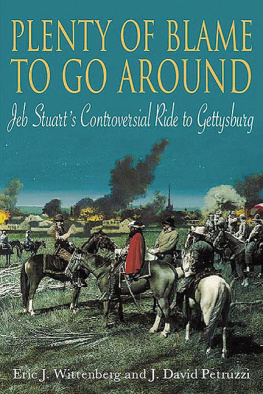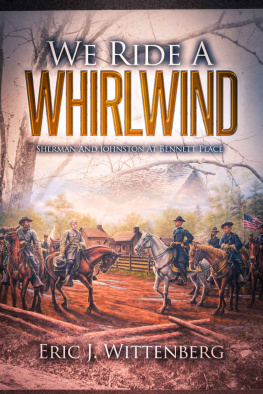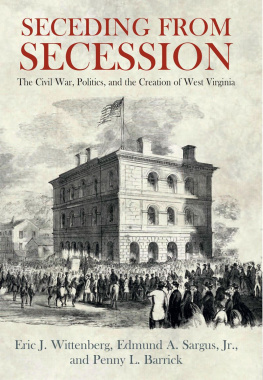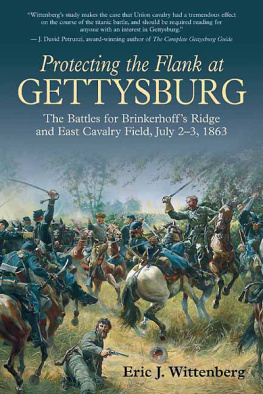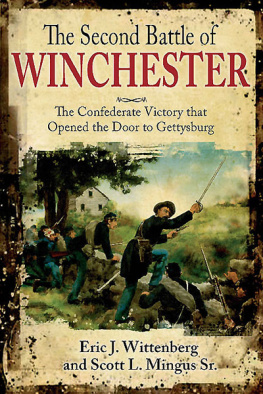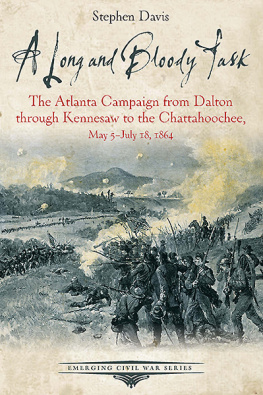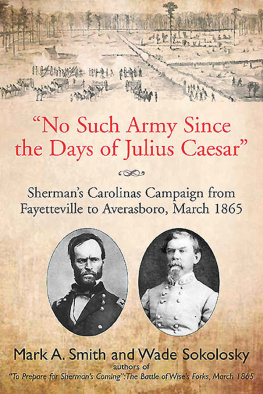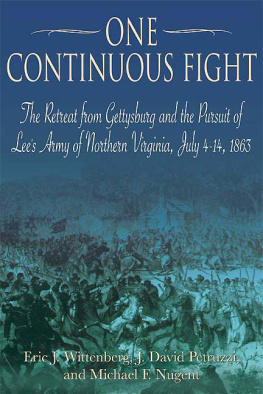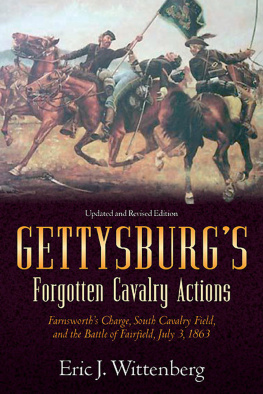Books by Eric J. Wittenberg
Gettysburgs Forgotten Cavalry Actions (1998)
We Have It Damn Hard Out Here: The Civil War Letters of
Sgt . Thomas W. Smith, Sixth Pennsylvania Cavalry (1999)
Under Custers Command: The Civil War Journal
of James Henry Avery (2000)
One of Custers Wolverines: The Civil War Letters of
Bvt. Brig. Gen. James H. Kidd (2000)
At Custers Side: The Civil War Writings of James Harvey Kidd (2001)
Glory Enough for All: Sheridans Second Raid and the
Battle of Trevilian Station (2001)
Protecting the Flank: The Battles of Brinkerhoffs Ridge and East
Cavalry Field, Battle of Gettysburg, July 2-3, 1863 (2002)
Little Phil: A Critical Assessment of the Civil War Generalship
of Philip H. Sheridan (2002)
The Union Cavalry Comes of Age: Hartwood Church to
Brandy Station (2003)

2006 by Eric J. Wittenberg
All rights reserved. No part of this publication may be reproduced, stored in a retrieval system, or transmitted, in any form or by any means, electronic, mechanical, photocopying, recording, or otherwise, without the prior written permission of the publisher. Printed in the United States of America.
Cataloging-in-Publication Data is available from the Library of Congress.
ISBN 1-932714-17-0
eISBN 9781611210156

Published by
Savas Beatie LLC
521 Fifth Avenue, Suite 3400
New York, NY 10175
Phone: 610-853-9131
Editorial Offices:
Savas Beatie LLC
P.O. Box 4527
El Dorado Hills, CA 95762
Phone: 916-941-6896
(E-mail) editorial@savasbeatie.com
Savas Beatie titles are available at special discounts for bulk purchases in the United States by corporations, institutions, and other organizations. For more details, please contact Special Sales, P.O. Box 4527, El Dorado Hills, CA 95762, or you may e-mail us as at sales@savasbeatie.com, or visit our website at www.savasbeatie.com for additional information.
For Susan
Did you ever see a cavalry charge? Imagine a thousand imps of darkness! A thousand fiends incarnate! Drawn up in battle array. In front of them is a line which must be broken. You hear the cannons roar! The bursting of shell! The crashing of the grape and canister! You see the men with saber drawn, with eyes flashing fire; every horse with head erect and champing his bit, as though he, too, were conscious of what was about to take place. They start! The tramping of hoofs resembling the roll of distant thunder; first a trot, then a gallop, then they charge with yells and loud huzzas, and, like maniacs, they rush upon the enemy. See the gaps in the line as the grape and canister crashes through them; you see them close up, boot to boot. There is no halting, but with a determination to do or die they rush their steeds ahead; then you hear the roll of musketry, the rattling fire of pistols, the clank of sabers, the shrieks of the wounded, and the groans of the dying; in a moment the vanquished run madly from the field, pursued by the victors, dealing death to their fleeting adversaries. These are the times that try mens souls, and call for heroic action.
Confederate cavalryman, November 1898
List of Illustrations
List of Maps
Judson Kilpatrick moves out to screen the main Union forces while
Wade Hamptons cavalry strike the advance, March 34, 1865
Captain Northrops 3rd Division Scouts raid
into Wadesboro, March 4, 1865
Jordans and Kilpatricks withdrawal and McBrides
Scout, March 56, 1865
Union forces cross the Pee Dee River/Confederates move
toward Fayetteville, March 67, 1865
Main force movements of Federal and Confederate units throughout South
Carolina and North Carolina, March 67, 1865
Movement of opposing forces from late afternoon to
early evening, March 9, 1865
Movement of opposing forces, night of March 9. and early
hours of March 10, 1865
Early moves of Wheelers cavalry to scout Kilpatricks camp,
night of March 9 and early hours of March 10, 1865
Wheelers cavalry closes the net on Kilpatricks camp,
early morning, March 10, 1865
Confedertate retreat and the burning of Cape Fear
River bridges, March 11, 1865
The Army of Mississippi halts to cross the Cape Fear
River, March 1115, 1865
Federal forces are pushed back and
Confederate forces move forward, March 15, 1865
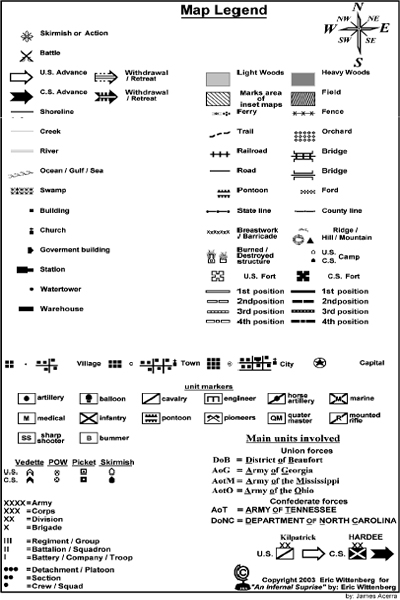
Preface
History descended on the two-room wooden home of James and Nancy Bennett near Durham Station, North Carolina, on April 17, 1865. Eight days earlier, Gen. Robert E. Lee had surrendered the tattered remnants of the Army of Northern Virginia at Appomattox Court House. General Joseph E. Johnston, who commanded most of the remaining Confederate forces in North Carolina, realized that once the possibility of a link-up with Lees army was gone, there was no hope for his vastly outnumbered force. Johnston, however wanted to make peace rather than just surrender his army. Major General William T. Sherman, Johnstons formidable adversary, also wanted to make peace in the hope of avoiding further bloodshed.
Johnston proposed a meeting between the two army commanders, and they selected James Bennetts place, approximately halfway between the positions held by the two foes. Thus, as one of Shermans staff officers noted, two great men came together in the heart of North Carolina, intent, with true nobility of soul and in the highest interest of humanity, upon putting a stop to the needless sacrifice of life.
The two generals entered the little Bennett house and began negotiating the terms, not just of the surrender of Johnstons army but of the end of the war and the restoration of the Union. Great things would happen in the small, plain parlor of the Bennett home, events of far-reaching consequence that remain largely unappreciated even today.
Each commander arrived with his staff and a cavalry escort. Lieutenant General Wade Hampton of South Carolina, Johnstons chief of cavalry, and Brevet Major General Judson Kilpatrick, Shermans cavalry chieftain, accompanied their respective commanders to the meeting at the Bennett house. Hampton and Kilpatrick were both transfers from the Virginia theater of operations, where they tangled a number of times during the first two years of the war. Although it is difficult to imagine more dissimilar personalities than these two men, they were familiar adversaries.
The horse soldiers mingled as they shook hands, shared war stories, and traded souvenirs. Colonel J. Fred Waring, commander of the Jeff Davis Legion Cavalry of Mississippi, engaged Major Llewellyn G. Estes, Kilpatricks assistant adjutant general, in conversation. To his great surprise, Waring discovered Major Estes was a pleasant, civil gentleman. I was treated civilly by all the officers I met. We recalled our fights in Virginia. Estes agreed, adding that it seemed like meeting old friends. Waring found Estess warmth a bit unsettling. Queer expression for a man who is ready to cut my throat when we next meet on the field, he observed. But he is a good fellow, if he is an enemy.
While waiting for Generals Johnston and Sherman to conclude their meeting, Hampton and his son, Lieutenant Wade Hampton, Jr., lounged on a carpenters bench outside the Bennett house. The elder Hampton wore his best uniform topped by a black felt hat adorned with gold braid and well shined cavalry boots. He left his sword behind that day in favor of a switchperhaps to send a message that he could still thrash any Yankee who crossed his path. The sight of his men and officers chitchatting with the enemy angered the aloof Hampton, who attitude that day was described as cold and bold beyond arrogance.


